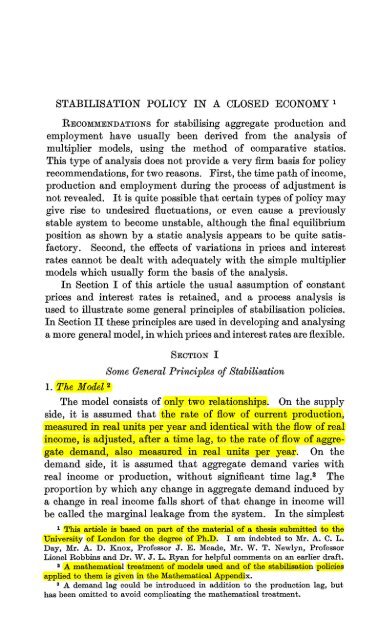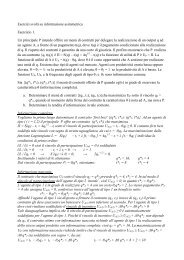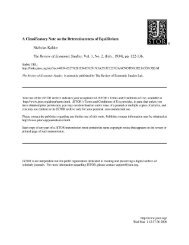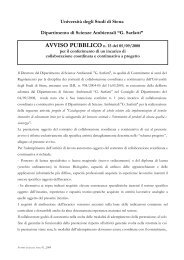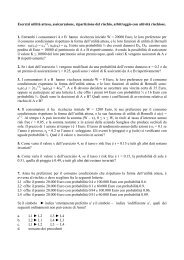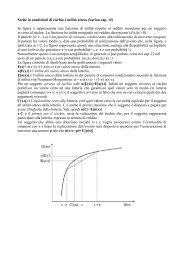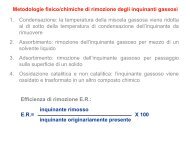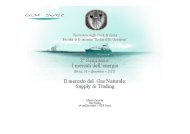Stabilisation Policy in a Closed Economy Author(s): A. W. Phillips ...
Stabilisation Policy in a Closed Economy Author(s): A. W. Phillips ...
Stabilisation Policy in a Closed Economy Author(s): A. W. Phillips ...
Create successful ePaper yourself
Turn your PDF publications into a flip-book with our unique Google optimized e-Paper software.
STABILISATION POLICY IN A CLOSED ECONOMY'<br />
RECOMMENDATIONS for stahilis<strong>in</strong>g aggregate production and<br />
employment have usually been derived from the analysis of<br />
multiplier models, us<strong>in</strong>g the method of comparative statics.<br />
This type of analysis does not provide a very firm basis for policy<br />
recommendations, for two reasons. First, the time path of <strong>in</strong>come,<br />
production and employment dur<strong>in</strong>g the process of adjustment is<br />
not revealed. It is quite possible that certa<strong>in</strong> types of policy may<br />
give rise to undesired fluctuations, or even cause a previously<br />
stable system to become unstable, although the f<strong>in</strong>al equilibrium<br />
position as shown by a static analysis appears to be quite satis-<br />
factory. Second, the effects of variations <strong>in</strong> prices and <strong>in</strong>terest<br />
rates cannot be dealt with adequately with the simple multiplier<br />
models which usually form the basis of the analysis.<br />
In Section I of this article the usual assumption of constant<br />
prices and <strong>in</strong>terest rates is reta<strong>in</strong>ed, and a process analysis is<br />
used to illustrate some general pr<strong>in</strong>ciples of stabilisation policies.<br />
In Section II these pr<strong>in</strong>ciples are used <strong>in</strong> develop<strong>in</strong>g and analys<strong>in</strong>g<br />
a more general model, <strong>in</strong> which prices and <strong>in</strong>terest rates are flexible.<br />
1. The Model 2<br />
SECTION I<br />
Some General Pr<strong>in</strong>ciples of <strong>Stabilisation</strong><br />
The model consists of only two relationships. On the supply<br />
side, it is assumed that the rate of flow of current production,<br />
measured <strong>in</strong> real units per year and identical with the flow of real<br />
<strong>in</strong>come, is adjusted, after a time lag, to the rate of flow of aggre-<br />
gate demand, also measured <strong>in</strong> real units per year. On the<br />
demand side, it is assumed that aggregate demand varies with<br />
real <strong>in</strong>come or production, without significant time lag.3 The<br />
proportion by which any change <strong>in</strong> aggregate demand <strong>in</strong>duced by<br />
a change <strong>in</strong> real <strong>in</strong>come falls short of that change <strong>in</strong> <strong>in</strong>come will<br />
be called the marg<strong>in</strong>al leakage from the system. In the simplest<br />
1 This article is based on part of the material of a thesis submitted to the<br />
University of London for the degree of Ph.D. I am <strong>in</strong>debted to Mr. A. C. L.<br />
Day, Mr. A. D. Knox, Professor J. E. Meade, Mr. W. T. Newlyn, Professor<br />
Lionel Robb<strong>in</strong>s and Dr. W. J. L. Ryan for helpful comments on an earlier draft.<br />
2 A mathematical treatment of models used and of the stabilisation policies<br />
applied to them is given <strong>in</strong> the Mathematical Appendix.<br />
3 A demand lag could be <strong>in</strong>troduced <strong>in</strong> addition to the production lag, but<br />
has been omitted to avoid complicat<strong>in</strong>g the mathematical treatment.


